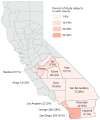Prenatal Exposure to Tobacco and Cannabis in Six Race/Ethnicity Groups during the First Three Years after Legalization of Cannabis for Recreational Use in California
- PMID: 38276799
- PMCID: PMC10815235
- DOI: 10.3390/ijerph21010011
Prenatal Exposure to Tobacco and Cannabis in Six Race/Ethnicity Groups during the First Three Years after Legalization of Cannabis for Recreational Use in California
Abstract
There are known health concerns linked to prenatal tobacco and cannabis exposures. This study aims to objectively determine the level of exposure to tobacco and cannabis in pregnant individuals from six race/ethnicity groups (Black, Hispanic, Asian Indian, Native American, Vietnamese, and White) in the first three years following legalization of recreational marijuana use in 2018 in California. We used a cross-sectional sample of prenatal screening program participants (2018-2020) from southern and central California (N = 925). Exposures were estimated by a lab analysis of cotinine (tobacco) and 11-hydroxy-Δ9-tetrahydrocannabinol (OH-THC, cannabis) in banked serum. Disparities in tobacco exposure were evident, with Black subjects experiencing the highest smoking rate (16%) followed by Native American (10%) and White (8%) subjects, and ≤2% among Hispanic, Asian Indian, and Vietnamese subjects. Environmental tobacco exposure generally showed a similar pattern of exposure to tobacco smoking across race/ethnicity groups. Cannabis detection ranged from 5% among Hispanic subjects to 12% and 13% among White and Black subjects, respectively, and was higher among tobacco users and those exposed to environmental tobacco smoke than those with no cotinine detected. Tobacco and cannabis exposure were generally greatest in younger subjects and those with indices of a lower economic status; however, among Black subjects, cannabis exposure was greatest in older subjects and those with a higher socioeconomic status. Race/ethnicity, age, and socioeconomic factors can inform targeting of high-exposure groups for intervention.
Keywords: 11-hydroxy-Δ9-tetrahydrocannabinol; THC; biomarker; cannabis; cannabis legalization; cotinine; pregnancy; tobacco.
Conflict of interest statement
Martin Kharrazi, Kimberly Berger, Ying Li, and Ilya Moskalenko are affiliated with “Sequoia Foundation”. The remaining authors declare that there is no conflict of interest.
Figures














References
-
- U.S. Department of Health and Human Services . The Health Consequences of Smoking: 50 Years of Progress. A Report of the Surgeon General. U.S. Department of Health and Human Services, Centers for Disease Control and Prevention, National Center for Chronic Disease Prevention and Health Promotion, Office on Smoking and Health; Atlanta, GA, USA: 2014.
-
- Accordini S., Calciano L., Johannessen A., Portas L., Benediktsdóttir B., Bertelsen R.J., Bråbäck L., Carsin A.E., Dharmage S.C., Dratva J., et al. A three-generation study on the association of tobacco smoking with asthma. Int. J. Epidemiol. 2018;47:1106–1117. doi: 10.1093/ije/dyy031. - DOI - PMC - PubMed
Publication types
MeSH terms
Substances
Grants and funding
LinkOut - more resources
Full Text Sources
Miscellaneous

